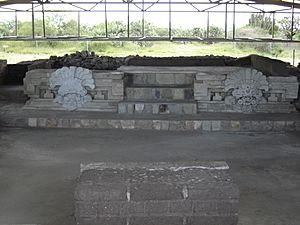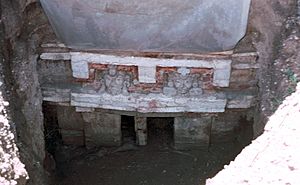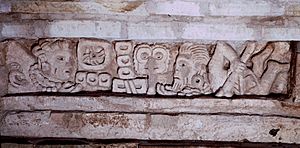Lambityeco facts for kids
Quick facts for kids Zapotec Culture – Archaeological Site |
||
| Name: | Lambityeco Archaeological Site | |
| Type | Mesoamerican archaeology | |
| Location | Tlacolula, Oaxaca |
|
| Region | Mesoamerica | |
| Coordinates | 16°58′18″N 96°29′31″W / 16.97167°N 96.49194°W | |
| Culture | Zapotec | |
| Language | Zapotec | |
| Chronology | 700 BCE to 750 CE | |
| Period | Mesoamerican Classical - Postclassical | |
| Apogee | 600 - 750 CE | |
| INAH Web Page | Lambityeco Archaeological Site | |
Lambityeco is a small ancient site in Oaxaca, Mexico. It is about 3 kilometers (2 miles) west of Tlacolula de Matamoros. You can find it off Highway 190, about 25 kilometers (15 miles) east of Oaxaca city. This site was important during the Late Classical Period.
The name Lambityeco might come from a few places. One idea is from the Zapotec word "Yehui," meaning "Guava River." Another thought is from "Lambi," a Zapotec version of the Spanish word "alambique" (still), and "Pityec," meaning "mound." So, it could mean "the still mound."
Many people believe Lambityeco means "Hollow Hill." This makes sense because the site was famous for making salt. People made salt here in ancient times and even as recently as 1940. They did this by pouring water through the dirt to get salty water. Then, they boiled this water in pots until only the salt was left. This city produced up to 90% of the salt used in the Oaxaca Valley between 600 and 700 AD.
Lambityeco is part of a bigger area called Yeguih, which means "small hill" in Zapotec. The two main buildings at Lambityeco are Mound 190 and Mound 195. Mound 190 was a fancy home with two large Cocijo masks at its entrance. Cocijo was the Zapotec rain god.
The site shows amazing art, like decorated pots, carved bones, and wall paintings in tombs. It also has beautiful stucco mosaics on its buildings.
Contents
Ancient Oaxaca and the Zapotec People
The state of Oaxaca is famous for its ancient cultures. The most well-known are the Zapotecs and the Mixtecs. There are 16 official native cultures in the state. These cultures have survived well because Oaxaca's mountains made it hard for outsiders to reach them.
The name Oaxaca comes from its capital city. This name comes from the Nahuatl word "Huaxyacac." It refers to a tree called a "guaje" (Leucaena leucocephala) that grows near the capital. The Aztecs, who spoke Nahuatl, first gave this name to the Valley of Oaxaca.
Most of what we know about ancient Oaxaca comes from digs in the Central Valleys. Scientists found signs of people living there about 11,000 years ago. This was in the Guilá Naquitz cave near Mitla. This cave is a UNESCO World Heritage site. It has the oldest known proof of farmed plants in the Americas. Corn cob pieces from the cave are the earliest evidence of corn farming.
More findings show that nomadic people lived here around 5000 BCE. They slowly started farming. By 2000 BCE, farming was common, and people lived in settled villages. Their diet included corn, beans, chocolate, tomatoes, chili peppers, squash, and gourds. They hunted animals like turkey, deer, and armadillo for meat.
The oldest big settlements, like Yanhuitlán and Laguna Zope, are also in this area. Laguna Zope is known for its small "pretty women" or "baby face" figures. Between 1200 and 900 BCE, people made pottery here. This pottery looks like similar work from La Victoria, Guatemala. Other important sites from this time include Tierras Largas, San José Mogote, and Guadalupe. Their pottery shows Olmec influence.
The Zapotecs were the first to become powerful in the Central Valleys. Their first major center was Monte Albán. This city was very important from 500 BCE until 750 CE. At its peak, Monte Albán had about 25,000 people. It was the capital city of the Zapotec nation. It stayed a Zapotec power center until the Mixtecs took it over in 1325.
Who Were the Zapotecs?
The Zapotec civilization was an ancient culture in the Valley of Oaxaca. It was part of southern Mesoamerica. Archeologists believe their culture started at least 2500 years ago. They left behind amazing buildings, ball courts, and grand tombs at Monte Albán. These tombs held beautiful gold jewelry and other treasures.
We don't know much about how the Zapotecs began. Unlike other ancient cultures, they didn't have stories about their origins. They believed they came directly from rocks, trees, and jaguars.
Archaeologist Marcus Winter describes how the Zapotec culture grew:
- Agricultural Stage (9500 to 1500 BCE): People started farming.
- Settlements Stage (1500 to 500 BCE): Villages began to form.
- Urban Stage (500 BCE to 750 CE): Big cities like Monte Albán grew.
- City-State Stage (750 to 1521 CE): Smaller city-states became important.
The Zapotec empire grew the most during the Monte Albán II period. Zapotecs took control of or settled areas far from the Oaxaca Valley. We can see this expansion in their pottery. Regions that had their own pottery styles suddenly started using Zapotec styles. This shows they became part of the Zapotec empire.
What Does "Zapotec" Mean?
The name Zapotec comes from the Nahuatl word tzapotēcah. This means "inhabitants of the place of sapote." Sapote is a type of fruit. The Zapotecs called themselves Be'ena'a, which means "The People."
The Lambityeco Site
The Lambityeco site has about 197 mounds spread over 117 hectares (289 acres). Most of these mounds are covered by plants. People lived at the site starting around 700 BC. It was most important at the same time as Monte Albán. The site was left empty around 750 AD. This also happened when Monte Albán was abandoned and the Zapotec state broke apart.
When the Zapotec state fell, many smaller settlements appeared in the Oaxaca Valley. It is thought that the people from Lambityeco might have moved to the Yagul site, which is a few kilometers west.
When Was Lambityeco Occupied?
Lambityeco was first settled around 700 BC, even before Monte Albán was founded. It was abandoned around 750 AD. The site was most important between 600 and 750 AD. This was a time of big changes in the Oaxaca Valley. Monte Albán was slowly losing power and being abandoned. Because of this, several smaller ceremonial centers, like Lambityeco, grew stronger.
These new centers took over political leadership. They might have also welcomed many people from Monte Albán. Unlike Monte Albán, Lambityeco has sculptures that show important royal marriages. These marriages were key to keeping political peace in later times. The first studies of these palaces and tombs happened from 1961 to 1976. John Paddock led these excavations.
Buildings at Lambityeco
Lambityeco has over 200 platforms. Sadly, only two have been fully explored: Structure 195 and Structure 190.
Structure 195: The House of the Great Lord
This building is the largest at the site, standing 6 meters (20 feet) tall. It has two sloped sections and stairs on its west side. You can still see parts of walls from a temple-patio-altar complex. The back part of the building was built near the end of the site's use.
Underneath, scientists found remains of six homes belonging to important families. There were also three tombs connected to these homes. These homes were used for about 115 years, with each family living there for 23 to 29 years over four or five generations.
The part of the building you can see today is called the House of the Great Lord. It was built with adobe bricks and covered in stucco. It has many rooms covering 370 square meters (about 4,000 square feet). The rooms around the north patio were likely bedrooms. The south patio was larger and more detailed. People believe governors met with the public here.
On the east side, there was a two-level altar with three parts. It had the special Zapotec style with recessed panels. Inside the altar, there are stucco figures. These figures show the governors of Lambityeco and their wives.
The figures on the northern wall show "Lord 4 Human Face" and "Lady 10 Monkey." They lived in the oldest palace between 600 and 625 CE. On the southern wall, you can see "Lord 8 Owl" and "Lady 3 Turquoise." They used the second palace between 625 and 650 CE.
Under the altar, you can find the entrance to Tomb No. 6. The front of the tomb has masks of "Lord 1 Earthquake" and "Lady 10 Reed." These were the last governors of Lambityeco.
The top level of the altar is mostly gone. It would have shown "Lord 8 Death" and "Lady 5 Reed," who were buried in Tomb 6. On the lower level, on the left, are "Lord 4 Face" and "Lady 10 Monkey." On their right are "Lady 3 Turquoise" and "Lord 8 Owl." These couples were the great-grandparents and grandparents of the last governors. Each male figure on the lower panels holds a human thigh bone. This showed their right to rule, passed down from their ancestors.
Tomb 6 is in front of this altar. Important lords and their wives were buried here. The tomb's front also has a recessed panel with stucco faces of "Lord 1 Earthquake" and "Lady 10 Reed." They were the parents of "Lord 8 Death." Inside the tomb, scientists found the remains of six people and 186 objects. Tombs in Oaxaca were often used many times. Older remains were moved aside to make room for new burials.
Structure 190: The Cocijo Patio
This building is 15 meters (50 feet) south of Structure 195. It's known as Cocijo Patio, but it was another fancy home. It covers almost 400 square meters (about 4,300 square feet). Rooms are built around two patios that face east-west. In front of each building, pottery is still stuck in the dirt floor. These might have been used for ceremonies.
Between the two patios, a small room was built. It had access to a higher level on the east side. This allowed for a stairway with two decorated walls. Each wall has a large mask made of stone and mud, covered with a thin layer of stucco. These masks show Cocijo, the Zapotec god of rain, thunder, and lightning.
These identical masks are one meter (3 feet) wide. They are amazing and special in Zapotec art. They show details that help us recognize Cocijo. He was one of the most important gods in the Zapotec religion.
The Cocijo image at Lambityeco wears a mask that covers most of his face. His eyes are framed by goggle-like shapes. A thick plate connects his nose to the bottom of the goggles and his mouth mask. On top of the mask is a large feather headdress and a "C glyph." Two ribbons with green stones hang from the headdress. His ears have earflaps over a feather base.
Cocijo also wears a chest plate. It looks like a round plate on top of a rectangle. It might represent a mosaic made of shell, jade, and obsidian. A unique feature is that Cocijo has arms. His right hand holds a pot from which water or a river flows. His left hand holds lightning bolts. This is why he is called the God of Thunder or Lightning.
Facing the Cocijo walls, at the end of the patio, is Tomb 2. It has stone walls forming an entrance room and a main room. The front of the tomb was built later. It has a recessed panel with double cornices. Inside, scientists found the remains of seven adults, representing at least four generations. They also found 144 objects. These included pots shaped like bat claws, incense burners with thorns, unbaked pots, carved bones, and five identical molded clay urns showing Cocijo.
People believe this was the home of the supreme priest. This priest controlled all religious matters. He was likely Cocijo's representative on Earth. This is suggested by the urns and masks in the central room. Ceremonies related to the Rain God were probably held here. This priest was usually related to the Great Lord, often described as his second son.
Recovered Images from a Lambityeco Tomb
After five months of careful work, a rare image of ancient governors was restored. It was found on the front of Tomb 6 at the Lambityeco site in Oaxaca.
These are the figures of "Lord 1 Earthquake" and "Lady 10 Reed." They are over 1300 years old. Specialists from the National Anthropology and History Institute (INAH) restored them.
The figures found at Lambityeco are famous for how realistic they are. They show features of a married couple that can still be seen in Zapotec women today.
See also
 In Spanish: Lambityeco para niños
In Spanish: Lambityeco para niños





